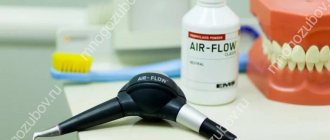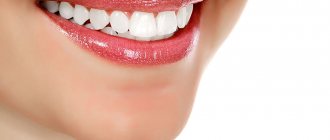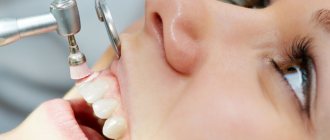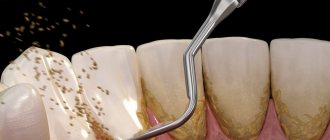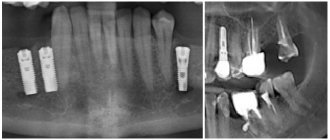From this article you will learn:
- what is aesthetic dental restoration,
- how it is carried out, patient reviews,
- price for restoration of front teeth in Moscow.
Artistic dental restoration is an aesthetic method of restoring damaged teeth, which gives them a natural appearance by simulating dental tissues with various materials. This method differs from conventional tooth filling in that in this case it is not just about restoring the shape and function of a damaged tooth, but when the doctor tries to achieve high aesthetics (so that the restored tooth cannot be distinguished from a healthy one). In dentistry, the terms aesthetic or cosmetic can also be used to refer to this type of restoration.
The artistic restoration method is more expensive compared to conventional traditional dental fillings, which has its justification. To achieve good aesthetics, it is important to restore not only the shape of the tooth, but also its color and transparency. Restoring the latter is the most difficult, because... Human teeth have different shades and transparency all the way from the cutting edge to the neck of the tooth. Therefore, making a tooth natural in color and transparency, as well as indistinguishable from neighboring teeth, requires not only skill and more expensive filling materials, but also a lot of time.
Dental restoration: photo (restoration of the 14th tooth, i.e. the first premolar of the upper jaw)
It should be clarified that the method of artistic restoration is used not only to restore teeth destroyed by caries, but also for congenital or acquired changes in the color of the enamel, age-related abrasion of teeth, chipping of the incisal edge, as well as for changing the unsightly shape of a tooth or moderate correction of its inclination. An alternative to the aesthetic restoration of teeth with filling materials can be other methods of cosmetic dentistry - ceramic and metal-ceramic crowns, as well as veneers.
Patient Victor, 48 years old (veneers on upper and lower teeth)
Restoration of chewing teeth –
In videos 3 and 4 you can see how the restoration of chewing teeth is carried out with composite filling material. In video 3, the restoration can hardly be called “artistic”, because... The chewing surface of the tooth with all its fissures was restored only “satisfactorily”. However, this video does a good job of showing the restoration of the side walls of the tooth and the contact points between the teeth. Video 4 shows the final stage of a truly artistic restoration.
October 2022
Every person sooner or later is faced with the need for dental treatment and prosthetics . He is sometimes faced with the very difficult question of choosing a method and design from the large number of options that modern dentistry offers. Of course, this choice must be made with the participation of a qualified specialist, but still the patient needs to get a clear idea of what the result will be in a particular case. Photos of teeth before and after the events help to do this in the best possible way.
This section presents the results of the work of our specialists, real cases from clinical practice: photos of the front teeth and their restoration, photos before and after orthodontic treatment , dental prosthetics and others.
They will help you better understand how effective a particular technique is. For example, by looking at a photo of the upper teeth before and after a person had veneers installed on his front teeth, you will be able to appreciate the excellent aesthetic effect achieved. with braces and aligners are amazing . And if you are going to have dental prosthetics, but you don’t know which prosthesis is best, look and choose the most suitable option and discuss the possibility of making it with your dentist.
The modern ARTOX clinic on Yugo-Zapadnaya provides its patients with high-quality dental services using the latest achievements of medical science. Our highly qualified specialists with many years of experience will help you achieve an attractive smile for many years.
Make an appointment with a dentist directly on the website or call: +7,.
Make an appointment
Methods of aesthetic dental restoration –
Probably, as you already understood, this article will talk about “direct restorations,” i.e. when tooth restoration is carried out using filling materials. However, there are also so-called “indirect restorations” (see below).
- Direct dental restoration – also known as dental restoration using light-curing composite material (i.e., photopolymers), and is done by dental therapists. It is this type of restoration that we will examine in detail in our article. This method also includes restoration of teeth with composite veneers, more about which you can read in the article at this link.
- Indirect dental restoration - in the manufacture of this type of restoration, an orthopedic dentist (prosthetist) takes part, as well as a dental technician sitting in a dental laboratory.
This includes prosthetics with ceramic veneers, metal-ceramic ceramic crowns, restorative ceramic inlays. In this case, the tooth is first prepared and then an impression is taken of it. Based on this impression, an inlay, veneer or crown is made in a dental laboratory, and then fixed to the teeth using cements. For indirect restoration methods, mainly only ceramics are used - this can be Emax, zirconium dioxide, feldspathic ceramics. If we are talking about aesthetic restoration with metal-ceramic crowns, then for their metal frame they use not an ordinary cobalt-chromium alloy, but alloys of precious metals (for example, gold-palladium). Alloys containing gold give metal-ceramic crowns a more natural shade. Read more about indirect restoration methods in the articles:
→ Restoration with ceramic veneers → Restoration with metal-ceramics → Restoration with ceramic crowns
Is it possible to install a crown if there is no natural tooth?
In the absence of natural teeth, the integrity of the front row can be restored using implants. Carrying out implantation does not require turning of adjacent elements. The crown is placed immediately after the implantation of the artificial root. This process can last from 2 months to six months.
Before installing implants, the doctor takes impressions or conducts three-dimensional computer modeling to obtain a virtual model of the future structure. Before the permanent prosthesis is fixed, the doctor places a temporary crown on the patient.
Types of dental crowns
In any clinic, patients can choose the type of future crown themselves, but without the help of a doctor it is very difficult to understand the types of prostheses, as well as evaluate the advantages and disadvantages of orthopedic structures. When choosing a crown, it is important to know what material it is made of.
✔
Metal ceramics.
✔
Solid ceramic.
✔
Ceramics E-max.
✔
Ceramic coated zirconium.
Metal ceramics
Products of this type have a very solid base. They create structures by alloying various metals: chromium, nickel, cobalt, gold, titanium. To make the dental crown look natural, the metal base is covered with ceramics. Layers are applied to the frame, after which the crown is fired to impart strength and integrity.
- Acceptable cost
- Wear resistance.
- Reliability.
- Change in color of soft tissues.
- Allergy to metal.
- Blueness of the gums.
- Significant grinding of the tooth.
Solid ceramic
When restoring teeth in the frontal zone, doctors recommend all-ceramic structures for aesthetic single prosthetics. All-ceramic crowns are made from pressed ceramic without the addition of additional materials. These are quite fragile products, so they are not used in the chewing department.
- Biocompatibility.
- Great aesthetics.
- Durability.
- Fragility.
- Impossibility of performing bridge prosthetics.
- Relatively high price.
E-max ceramics
The problem of the fragility of a material such as ceramics was solved by glass-ceramic crowns E-max. They are not only very durable, but also distinguished by high aesthetics. This is an excellent option for front teeth. The E-max crown looks natural and does not stand out among natural teeth.
- Strength.
- Aesthetics.
- Reliability.
- Natural transparency.
- High price.
Zirconium
In the popularity rating, zirconium crowns have been occupying first place for several years. In terms of strength, aesthetic products made from zirconium dioxide are not inferior to metal, which makes it possible to create orthopedic structures of the highest quality. The hard material enhances the strength of teeth and restores their size and shape.
- Excellent biocompatibility and thermal conductivity.
- Inertness of the material.
- Kink resistance.
- Lack of natural transparency.
- High price.
Ceramic crowns on a zirconium frame
This type of crown is an excellent opportunity to combine strength, reliability, and high aesthetics. The products are as reliable and durable as metal-ceramic crowns. They do not deform during use and serve for a long time. The ceramic layer gives the artificial tooth a natural appearance.
- They look natural.
- Hypoallergenic.
- Withstands heavy loads without risk of damage.
- Quite a high cost.
Restoration with crowns is indicated in the following cases:
- aesthetic defects (chips, stains, cracks, diastemas, trema, curvature, etc.);
- single or complete destruction of teeth with preservation of the root;
- uneven gum line;
- bite pathology;
- pathological abrasion and discoloration of enamel;
- restoration of lost functions (biting, sharing food, diction).
The front incisors are not associated with the chewing function, so there are no strict requirements for the strength of the crowns. The doctor’s task is to recreate the anatomical shape and color of natural teeth, maintain their degree of transparency, and achieve a perfect match of sizes.
Contraindications to the procedure
Fortunately, there are not many of them. An absolute contraindication is an allergic reaction to composite materials.
Relative contraindications:
- some types of malocclusions;
- bruxism (grinding teeth during sleep);
- patient's failure to comply with oral hygiene;
Light-curing materials should be used with caution if the patient has a pacemaker.
Using the direct method of restoring teeth is difficult if it is impossible to protect the restoration site from moisture.
Veneers or crowns: which is better?
You can restore your front teeth using veneers. Non-removable pads are attached to the turned elements. The procedure is much faster than prosthetics, but before making the final choice between veneers and crowns, consult your doctor. Durable ceramic onlays are classified as restoration methods in cosmetic (aesthetic) dentistry. Veneers that protect the surface of the tooth accurately imitate enamel, hiding all imperfections, but in case of significant damage and destruction they are not used. In these cases, crowns are installed.
Tom Cruise, 56 years old
In photographs of Tom Cruise at different ages, slight problems with his bite are visible: he moves slightly to the left, which causes a violation of the central axis, while the shape of the teeth remains unchanged. Conclusion: Tom Cruise has never done anything drastic with his teeth. But he watches them very carefully, regularly goes for medical examinations, cleanings and treats them as needed.
Fixed prosthetics options
Prosthetics with fixed structures will look most beautiful. Most of them not only preserve the shape of teeth and extend their service life, but also allow them to function fully. Fixed dentures are strong and durable, securely fixed and do not cause any discomfort to their owners.
Fixed structures can solve a whole range of problems at once:
- eliminate cracks, chips and cracks,
- correct minor curvature,
- return a beautiful shade of enamel,
- hide old fillings,
- restore severely damaged teeth,
- protect the enamel from abrasion and external influences,
- fill the gap of one or more teeth in a row.
You should always remember that prosthetics with fixed products is contraindicated in case of significant malocclusion, bruxism, or mental disorders. It is also worth excluding periods of pregnancy and decreased immunity. And before the procedure, it is recommended to cure all inflammations in the oral cavity.
Veneers
Thin and fragile plates made of composite material, ceramics or zirconium are installed on the front side and hide all external defects. They do the best job of restoring aesthetic function, and they look so natural that only a specialist can distinguish them from natural teeth.
Note! It is necessary to protect veneers from excessive loads. If the lining is damaged, it will be impossible to repair it and will have to be replaced completely.
The main disadvantage of overlays is the need to grind the enamel before installation. Therefore, teeth without veneers need urgent restoration, otherwise they will not look aesthetically pleasing, remain unprotected and are susceptible to harsh environmental influences.
Lumineers
After prosthetics with ultra-thin lumineers, which do not require grinding of the enamel, the patient is guaranteed an impeccable “Hollywood” smile, characterized by evenness and whiteness. However, it will not be possible to immediately restore teeth with onlays - treatment can take from 1 to 3 months: you will need to perform preliminary sanitation of the oral cavity, and also wait for dentures, because they are created based on individual impressions of the patient’s teeth only in a US laboratory, and then transported to Russia. Compared to veneers, this is a more expensive option, but does not require enamel removal and lasts for more than 20 years.
The photo shows lumineers
Dental inlays
Ceramic or zirconium inlays are very durable and therefore last several times longer than conventional fillings. They restore not only the anatomical shape of the tooth, but also restore its functionality, making the process of chewing food as comfortable as possible. Inlays are created in a laboratory, individually for the patient, so they fit more tightly to the tooth, which reduces the risk of damage to its walls and the development of caries under the prosthesis.
Zirconium dioxide inlays
Crowns for restoring the tops of teeth
The purpose of crowns is to restore the upper part, as well as protect a damaged tooth from exposure to a negative environment, preserve the root, and provide comfort when chewing food. Their anatomical shape and perfectly matched shade make it possible to make the presence of prostheses invisible to others. The only drawback is that before installing a crown, the tooth is subjected to grinding on all sides, and in some cases it is even depulped.
Important! Metal ceramics have the best characteristics for restoring chewing teeth. Crowns made from this material are strong and reliable. But, despite their visual appeal, the metal can be translucent, so in the smile area it is better to use zirconium or ceramics, the aesthetics of which are beyond praise, and they do not oxidize over time and do not cause darkening of the gums.
Crowns can also be made and firmly fixed to the implant in cases where the root is missing. This restoration method is rightfully considered the most effective and durable.
The photo shows a tooth restored with a crown.
Prosthetics with dental bridges
A dental bridge is installed when one or more teeth in a row are missing along with the roots. It can be supported by both neighboring teeth and implants implanted into the bone tissue. Bridges completely restore the appearance and functionality of teeth. To create them, metal-ceramics, metal-plastic or zirconium are used. The best option in terms of price and quality is considered to be a metal-ceramic dental bridge.
Dental bridge
When is tooth augmentation required?
The following procedure should be followed:
- with congenital anomalies of teeth (underdevelopment, absence of a dental unit, presence of a gap between teeth),
- age-related changes resulting in missing or deformed teeth,
- malocclusion,
- chipped tooth enamel,
- serious damage to the tooth by caries,
- stains or thinning enamel.
These defects must be eliminated, since damaged teeth are the cause of the development of inflammatory processes. They arise because pathogenic microorganisms easily penetrate deep into tissues through chips, cracks and carious cavities and cause infection.
However, extensions have contraindications:
- allergy to the material,
- hilar cysts,
- bite pathologies corrected by braces,
- untreated dental diseases (periodontitis, stomatitis),
- bruxism (involuntary grinding of teeth).
Important! For some patients, age over 60 years may be a contraindication. This applies to people with severe chronic diseases of the heart and circulatory system.
Options for restoration of the anterior region with crowns
For patients and dentists, the front teeth have always been the most problematic. In the last century, people were given metal crowns to preserve chewing function. There were no other alternatives. Such structures coped with the chewing function, but looked very unaesthetic, oxidized, caused allergies and galvanic syndrome (taste in the mouth). The most expensive and fashionable were gold dentures. Products made of ductile metal did not oxidize, did not cause rejection, and did not wear out for a long time. But the shiny yellow crowns were conspicuous and did not look like natural teeth, so over time, fashion changed, and this restoration technology was replaced by more modern techniques.
Today, patients have the opportunity to painlessly and quickly get rid of all defects associated with damage or loss of teeth in the frontal area, including the complete absence of dentition. In shape, shade and transparency, artificial analogs are almost no different from natural teeth, and their strength allows you to forget about any problems for a long time.
Crown for front tooth: prices in Moscow
The cost of crowns is not affected by the type of teeth being restored, that is, it does not matter which elements the doctor prosthetizes, upper or lower. The price depends on the number of artificial crowns, the method of their installation, the material, and accompanying therapeutic procedures.
Information on the cost of treatment services can be found on the websites of dental clinics. We present average figures for Moscow.
The price of installing one metal-ceramic crown starts from 9,000 rubles. The cost of ceramic products is from 20,000 rubles. Costs for installing zirconium crowns start at 25,000 rubles. While the permanent crown is being made, the patient wears a temporary structure; it costs 1,500–2,000 rubles.



